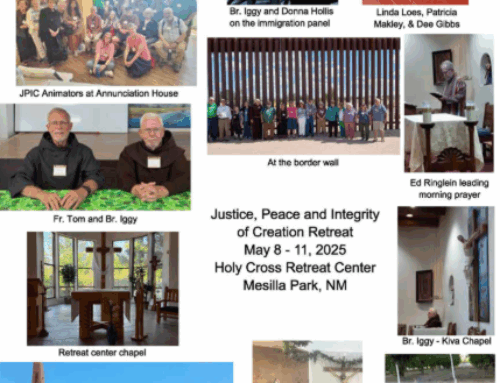Canticle of the Creatures Reflections – Part 2
(This article originally appeared in the TAU-USA Summer 2025 Issue #116)
Praised be You, my Lord, through our Sister Bodily Death,
from whom no one living can escape.
Woe to those who die in mortal sin.
Blessed are those whom death will find in Your most holy will,
for the second death shall do them no harm.
Sister Bodily Death
by Justin Carisio, OFS
In Francis of Assisi, Writer and Spiritual Master, Thaddée Matura, OFM, observes that St. Francis “loved to write or have others write for him. He insisted on the preservation of what he wrote, and he called for the transmission, knowledge and putting into practice of his writings.”[1] Murray Bodo, OFM, reminds us that Francis’ “whole being was that of a poet…he walked and praised as a poet would as he followed Jesus.”[2]
In this calendar year 2025, we acknowledge Francis as writer and poet by celebrating the 8th centenary of his magnificent poem of praise, “The Canticle of the Creatures.” Because of our contemporary focus on care for creation and the designation of St. Francis as patron of ecology, much attention will be given to the first nine verses of the Canticle. These deal with inanimate creatures of the natural world. Brought into existence by our heavenly Father, each is called brother or sister by Francis. He announces their beauty and attributes. He proclaims that through the creatures, God is to be praised.
But the Canticle is about more than nature. It is “a poem of St. Francis’ soul.”[3] We see this nowhere more poignantly than in the final verses. Francis wrote verse 12 as he lay dying: “Praised be You, my Lord, through our Sister Bodily Death, / from whom no one living can escape.”[4]
Franciscans have a long-established custom of referring to “Sister Death.” Yet Francis did not speak of Sister Death in the Canticle. Writing in his Umbrian vernacular, he was quite intentional in naming this sister he was soon to meet: “Laudato si, mi Signore, per sora nostra Morte corporale.” He speaks of Sister Bodily Death.
Why belabor what appears to be an inconsequential point? Precisely because it is consequential.
Poets measure every word, and Francis wrote “Sister Bodily Death.” Nevertheless, Franciscans have often chosen to express this otherwise. Indeed, in the text of the Canticle in the English Omnibus of Sources – a mainstay reference for many years – the verse does read “All praise be yours, my Lord, through Sister Death.”[5] No mention of the body.
There may be other reasons why usage has favored the truncated Sister Death. Some of the early documents speak of the dying Francis welcoming Sister Death. In English at least, it comes more readily off the tongue when spoken. It is also less graphic than “Sister Bodily Death,” and thus less discomfiting.
Yet, it is likely Francis intended to be graphic. His images in the Canticle favor the bold and the descriptive. When he added this verse in his last days, he was blind and suffering physically. We must conclude he chose his words with care, saying exactly what he meant to say. Fortunately, the editors of Francis of Assisi: Early Documents chose an English translation that conveys the saint’s original words. That text now appears to be predominant, assuming online presentations of the Canticle are representative.
If we want to honor St. Francis’ great hymn of praise these 800 years later, perhaps we can make a resolution: Let us say consciously “Sister Bodily Death” henceforth. In so doing, we can lend renewed power to his poetic voice and show deep respect for the actual words he chose and which he intended us to know and repeat.
[1] Thaddée Matura, OFM, Francis of Assisi Writer and Spiritual Master, trans. by Paul Lachance, OFM (Cincinnati: Franciscan Media, 2005), xiii.
[2] Murray Bodo, OFM, Poetry as Prayer Saint Francis of Assisi, (Boston: Pauline Books & Media, 2003), 56.
[3] Murray Bodo, OFM, Poetry as Prayer Saint Francis of Assisi, (Boston: Pauline Books & Media, 2003), 56.
[4] St. Francis of Assisi, “The Canticle of the Creatures” in Francis of Assisi: Early Documents (FA:ED I), edited by Regis Armstrong, J. A. Wayne Hellmann, William J. Short (New York, London, and Manila: New City Press, 1999), 114.
[5] 5 St. Francis of Assisi, “The Canticle of Brother Sun,” St. Francis of Assisi Writings and Early Biographies English Omnibus of the Sources for the Life of St. Francis, Marion A Habig, ed (Chicago: Franciscan Herald Press, 1983), 131.




Leave A Comment